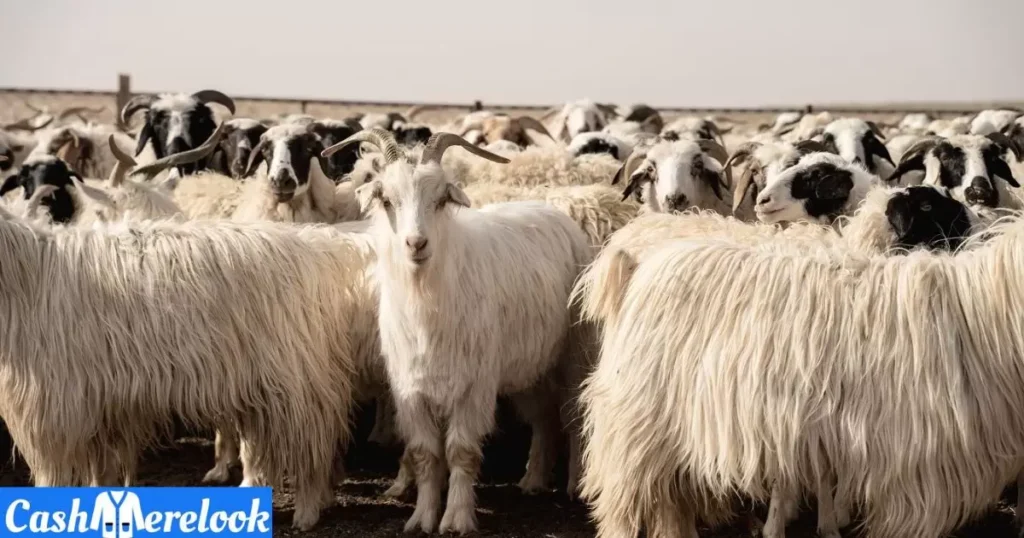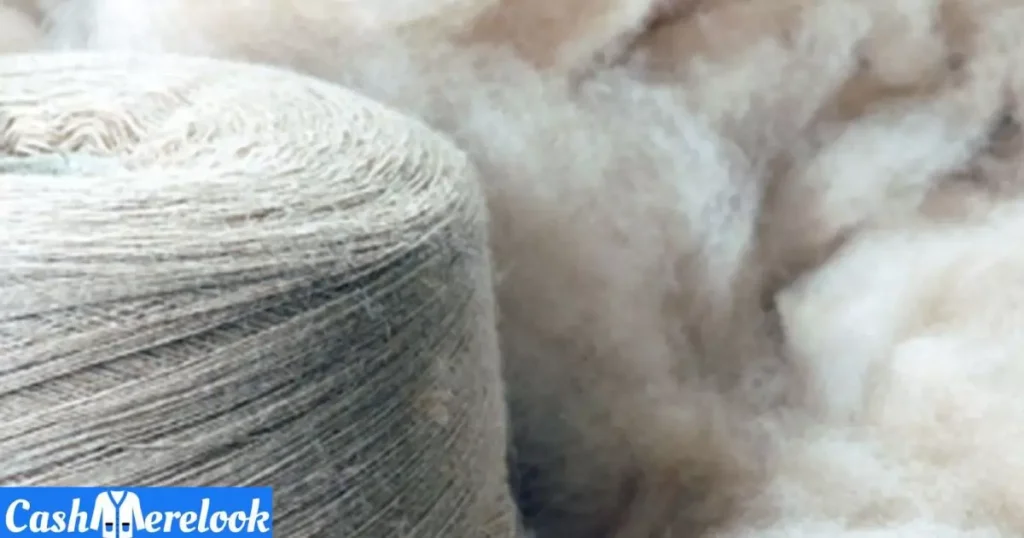Cashmere is a super soft material made from the hair of special goats. People use it to create really warm and comfy clothes, like sweaters and scarves, that feel amazing to wear. It’s like wearing a cozy hug, perfect for chilly days!
“It is a soft and fancy material made from the hair of special goats. People use it to make warm and cozy clothes that feel nice to wear. Ever wondered why it’s so popular for creating luxurious garments? Using not only ensures warmth but also adds a touch of elegance to your wardrobe.”
Cashmere, derived from special goats’ fur, is employed to fashion luxurious and soft garments like sweaters. Its exquisite quality provides a lavish and cozy feel, making it perfect for creating clothing that offers both luxury and comfort.
History of cashmere fiber

“The term ‘cashmere’ primarily refers to the fine wool obtained from the undercoat of special goats. The origins can be traced back to the high plateaus of Central Asia, including regions in China, Mongolia, Afghanistan, and Iran. However, the name itself is derived from the Kashmir region, which played a pivotal role in the production and trade of this exquisite wool.”
Historical Significance
Cashmere has a long-standing association with luxury and opulence. Its use dates back to ancient times, with evidence suggesting that its wool was used in textiles as early as the 3rd century BC. The rarity and softness of the fiber made it highly coveted among royalty and the affluent elite.
During the Middle Ages, the trading routes known as the Silk Road facilitated the spread of cashmere textiles to the Middle East and Europe. The exquisite craftsmanship and quality of Kashmiri shawls, in particular, gained immense popularity. European elites, including Napoleon Bonaparte and Empress Josephine, contributed to the global fascination with cashmere.
Journey of Kashmir to Cashmere:
The Kashmir region, nestled in the northern part of the Indian subcontinent, played a central role in the production of cashmere wool. The harsh winters and the distinctive climate of Kashmir are ideal for raising the special breed of goats that produce this luxurious fiber.
Kashmir became synonymous with high-quality cashmere textiles, especially shawls, during the 15th to 17th centuries. The intricate designs and craftsmanship of Kashmiri artisans garnered international acclaim. The Mughal emperors, who ruled over the Indian subcontinent, were particularly instrumental in promoting the Kashmiri textile industry.
Over time, the term “cashmere” evolved from the original “Kashmir,” and the region became renowned for producing some of the world’s finest wool. “The combination of traditional craftsmanship and the natural resources of Kashmir contributed to the enduring legacy of this exquisite fiber as a symbol of luxury and refinement.
Production Process of Cashmere

Cashmere Goat Breeds:“Expertise in production begins with selecting the right goats. Special breeds, like the Cashmere goat, are chosen for their soft and fine wool. These goats grow a unique kind of hair that becomes the luxurious.”
Harvesting and Collection:“Once a year, it’s time for a “haircut.” The goats are gently sheared, and this collected wool becomes the starting point for our cozy cashmere products.”
Sorting and Cleaning: The gathered cashmere undergoes a spa day! It gets cleaned thoroughly to remove any dirt or bits. Then, it’s like a hair salon – the fibers are sorted to keep the longer, softer ones for making the best quality cashmere.
Spinning and Weaving: After the spa treatment, it’s time to spin the cleaned cashmere fibers into yarn. This yarn is then woven or knitted into the fantastic products we enjoy, like scarves or sweaters. It’s like turning fluffy clouds into something we can wear and feel super cozy in.
Applications and Uses

Here are the applications and uses of cashmere fibers.
clothing
Sweaters: “Widely used in sweater production, this exceptional material is chosen for its softness and warmth. Sweaters made from it provide a luxurious and comfortable option for both casual and formal occasions.”
Scarves: Scarves are popular for their lightweight yet insulating properties. They add a touch of sophistication to outfits while keeping the wearer comfortably warm.”.
Shawls: Cashmere shawls are known for their elegance and versatility. They are often used as stylish accessories for evening wear, providing a delicate layer of warmth.
Accessories
Gloves: Cashmere gloves are favored for their softness and insulation. They offer a high-end option for keeping hands warm in colder weather while maintaining a stylish appearance.
Hats: Whether in the form of beanies or classic hats, cashmere is utilized to create headwear that combines fashion with functionality, providing both style and warmth.
Socks: Cashmere socks are prized for their plush texture and thermal properties. They are a luxurious choice for footwear, ensuring comfort and warmth for the feet.
Blankets and Throws: Cashmere blankets and throws are sought after for their unmatched softness and lightweight warmth. They add a touch of luxury to home décor, providing both comfort and style.
Bedding: Cashmere is used in bedding, including sheets and pillowcases, to offer a sumptuous sleep experience. Its natural insulating properties contribute to a cozy and restful night’s sleep.
Upholstery: Cashmere is employed for upholstery in home furnishings, transforming furniture into elegant and comfortable pieces. Cashmere-upholstered items bring a sense of opulence to living spaces.
Other Specialized Uses
- High-end Fashion: Cashmere is a staple in high-end fashion, gracing the runways of renowned designers. Its use in clothing collections signifies a commitment to quality, comfort, and a timeless sense of style.
- Luxury Goods: Beyond apparel, cashmere is utilized to create various luxury goods such as handbags and accessories. These items showcase the material’s exclusivity and contribute to the overall sophistication of the product.
- Artisanal Crafts: Craftsmen often incorporate cashmere into artisanal crafts, creating unique and handmade pieces. Whether in artistic textiles or bespoke creations, cashmere’s versatility is showcased in these one-of-a-kind items, emphasizing both craftsmanship and luxury
Properties of cashmere
Cashmere fiber is renowned for its luxurious qualities, making it a highly coveted material in the textile industry. Here are some key properties of cashmere:
- One of the most distinctive features is exceptional softness. The fine fibers have a silky, smooth texture that feels luxurious against the skin.
- Despite its lightweight nature, it provides excellent insulation, keeping the wearer warm in cold weather. The fibers have a unique ability to trap and retain heat, making garments ideal for winter wear.
- It is a lightweight material, making it comfortable to wear without adding bulk. This quality makes garments versatile and suitable for various seasons.
- Despite its warmth, it is breathable, allowing air circulation and preventing overheating. This makes it a comfortable choice for a wide range of temperatures.
- While it is delicate and requires proper care, it is surprisingly durable for its fineness. High-quality garments, when well-maintained, can withstand regular use and last for many years.
- Fibers have natural insulating properties, adapting to the body’s temperature. This means that it can help regulate body temperature by keeping you warm when it’s cold and cool when it’s warm.
- It can absorb moisture without feeling damp. This makes it comfortable to wear in various climates, as it can wick away perspiration and keep the skin dry.
- Fibers are naturally elastic, allowing the material to stretch without losing its shape. This flexibility contributes to the durability and comfort of garments.
- It has a subtle sheen or luster that enhances its visual appeal. The natural shine of the fibers adds to the luxurious appearance of textiles.
- It is often considered hypoallergenic because the fibers are finer and smoother than many other types of wool. People with wool sensitivities may find it to be a more comfortable option.
- It is versatile and can be woven into various types of textiles, including sweaters, scarves, shawls, and even lightweight summer garments. Its adaptability makes it a popular choice for a wide range of fashion items.
- In summary, the properties make it a sought-after material for its combination of softness, warmth, and versatility. It has a timeless appeal that continues to make it a staple in high-quality, luxury fashion.
Conclusion
In simple terms, it’s a special type of soft and warm wool obtained from the hair of special goats. This luxurious material is used to make cozy and comfortable clothing like sweaters, scarves, and shawls. People love it for its softness, warmth, and how good it feels against the skin. It’s like wearing a warm hug, making it perfect for staying snug in cold weather. So, in a nutshell, it is used to create some of the most comfortable and stylish clothing items that keep you warm and cozy.












